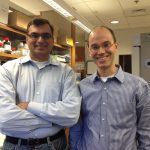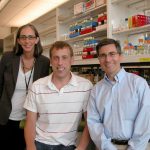The V Foundation for Cancer Research’s “Team V” Exceeds $540,000 Fundraising Milestone in 2024
Read moreState: North Carolina
Victoria Seewaldt, M.D.
Funded by the Jimmy V Women’s Basketball Classic
Gerold Bepler, M.D., Ph.D.
Corinne Linardic, M.D., Ph.D.
Funded by the Apple Gold Group
Rhabdomyosarcoma (RMS) is the most common soft tissue cancer of childhood. Because RMS has features of skeletal muscle, we and others have been trying to understand how muscle development pathways inside the tumor cells have gone awry. This project will study the role of a protein called SFRP3, which although it takes part in normal muscle formation, is co-opted to support RMS tumor formation. We aim to understand in more detail how SFRP3 works in RMS, and how to block it. Our goal is to someday use SFRP3 blockade as a therapeutic intervention.
Daniel Wechsler, M.D.
Funded by the Apple Gold Group
The CALM-AF10 chromosomal abnormality is seen in aggressive pediatric and adult acute leukemias that have a poor prognosis. Our lab has discovered that CALM-AF10 interacts with CRM1, a protein that helps transport other proteins from the nucleus to the cytoplasm. This interaction is required to activate HOXA genes, which play a critical role in both CALM-AF10 and other leukemias. This discovery suggests that CRM1 may be important in other leukemias as well, as is significant because a new class of drugs that inhibit interaction with CRM1 (SINEs-Selective Inhibitors of Nuclear Export) has recently been developed. These drugs are effective in a number of human tumor types, and are currently in clinical trials for adult leukemias. Our studies indicate that SINEs may block cancer cells through an unappreciated and novel mechanism-inhibiting CRM1 involvement in activating HOXA genes. In this proposal, we will examine the molecular mechanisms by which CRM1 activates HOXA genes. We will then identify additional CRM1 target genes that are involved in causing leukemias. Studying this previously unrecognized role for CRM1 will enhance our understanding of how SINEs work, and provide preclinical support for their use in pediatric leukemia clinical trials. Since HOXA genes are involved in many hematopoietic malignancies (including MLL-fusion leukemias that are seen in 80% of infant leukemias), these studies may have broad implications for leukemogenesis.
Qing Zhang, Ph.D
Triple Negative Breast Cancer (TNBC) accounts for 15-25% of breast cancers. TNBC is well known for its aggressive clinical behavior and early peak of recurrence. Due to the lack of good therapeutic targets, TNBC represents the specific subtype of breast cancer with worst prognosis. Therefore, there remains the urgent question to be addressed: Can we identity important biological features that serve as high value targets for the development of novel treatment modalities for TNBC? This line of research carries significant social and economic importance. Hypoxia is a characteristic of solid tumor, which contributes to radiation and chemotherapy resistance. One important feature of tumor cells is that they sense the oxygen tension and rewire their signaling pathway to survive under harsh living conditions. EglN2 prolyl hydroxylase serves as an important oxygen sensor. In this proposal, we presented some preliminary data in the TNBC cell lines that getting rid of EglN2 could decrease TNBC tumor growth and invasion. We propose to obtain primary tumors from TNBC patients, implant them into mice and treat them with siRNA nanoparticles that deplete EglN2, which will be used to test the efficacy of targeting EglN2 in a patient relevant system. In addition, we will study mechanistically how EglN2 protein stability is regulated by FBW7 E3 ligase complex. Furthermore, we will implement a novel screening for EglN2 specific inhibitors, which will motivate testing the effect of these potential inhibitors on TNBC tumorigenesis. Successful completion of proposed research will open new therapeutic avenues in treating TNBC.
John Cavanagh, Ph.D.
Funded by a challenge grant with
North Carolina State University
The Jimmy-NCSU V Cancer Therapeutic Program allows young researchers the opportunity to work on multiple facets of cancer research in a set of diverse labs, each investigating different approaches for developing cancer therapeutics.
Enhancing cancer drugs
We have discovered molecules that increase the effects of anticancer drugs by several orders of magnitude. Our goal is to reduce the working concentrations of all anti-cancer drugs in order to mitigate serious side effects. We will develop and screen our new molecules with both novel and existing chemotherapeutics against a variety of cancer cell lines in order to define the optimum combination treatment. Initial screens show effects against breast, renal and colon cancer cell lines.
Cell death and tumor formation
The life and death of cells must be balanced. Normal cells accommodate this balance by invoking programmed cell death pathways, referred to as apoptosis. In cancer cells, these pathways are defective and normal cell death does not occur, leading to tumor formation. In addition, faulty apoptosis causes tumor cells to be resistant to chemo/radiation therapies. If we could make apoptosis occur properly, we slow down tumor formation and overcome this resistance.
The protein caspase-3 controls apoptosis. If caspase-3 fails to function, cell death does not happen correctly. We also know that the protein calbindin-D28K binds to caspase-3 and stops it functioning. If we can stop calbindin-D28K from interfering with caspase-3, apoptosis would occur normally and the risk of cancer developing would be reduced. Consequently calbindin-D28K is a powerful target for anticancer drug development.
Michael B. Major, Ph.D., D. Neil Hayes, M.D., MPH, Gary Johnson, Ph.D.
Protein kinases are a family of 518 human proteins which receive and transmit information within the cell, often from one kinase to another. The information flow within the network governs all aspects of cell biology, including cell growth, movement and survival. Not surprisingly, cancer very often re-wires kinase activity and connectivity to support its uncontrolled growth and metastasis. Indeed, protein kinases are the most commonly mutated protein family in human cancer. Protein kinases are also exceptionally ‘druggable’ and constitute the most tractable class of new therapeutic targets. Two significant challenges exist. First, we know a great deal about very few protein kinases. There is no doubt that targeting understudied kinases in cancer will benefit patients, but what kinases and for which patients? Second, several kinase inhibitors have proven immensely effective in certain cancers, however not all patients respond and for those that do respond, resistance inevitably emerges. We now know that cancer reprograms the kinase network to bypass chemotherapy. To tackle these challenges, we have developed a new technology that allows us to identify and quantify the activity of nearly all kinases in a single experiment. This allows us to comparatively study kinase activity in normal cells and in cancer cells, in chemotherapy-sensitive and resistant cancers, and in tumors before and after relapse. We hypothesize that the responsiveness of cancer to targeted therapy is determined by the baseline activity of specific kinases and the nature by which these activities adapt to therapeutic challenge. We will test this hypothesis in tumors of the lungs and head and neck. Together, our experiments may lead to the identification of specific kinase activities which: 1) predict cancer disease progression, 2) predict response to therapy, and 3) suggest new and rationally designed therapeutic strategies for patients with naïve and relapsed cancer.













